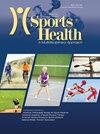Gait Characteristics and Deviation Factors of Backward Walking in Patients With Chronic Ankle Instability
IF 2.7
2区 医学
Q1 SPORT SCIENCES
引用次数: 0
Abstract
Background:Despite growing applications of backward walking (BW) in assessing and rehabilitating neuromuscular conditions, its effects on gait in chronic ankle instability (CAI) remain unclear. Moreover, linking patient-reported and clinically generated measures is imperative for understanding CAI.Hypotheses:Patients with CAI will exhibit worse and compensatory spatio-temporal and kinetic gait parameters during BW, and patient-reported outcomes (PROs) will be correlated significantly with gait parameters.Study Design:Case-control study.Level of Evidence:Level 4.Methods:A total of 46 volunteers participated (23 per group). Patients filled out scales for pain, functions, and fear-avoidance beliefs before testing. All participants walked 6 times each in both forward and backward conditions, and gait was recorded using the Win-Track system. A 2-way mixed analysis of variance was performed to compare gait parameters. The relationship between PRO and gait outcomes was assessed through the Pearson product correlation coefficient.Results:The CAI group demonstrated prolonged support and swing phases, increased walk-off angle, and plantar pressure area, but decreased step length and plantar pressure versus controls ( P < 0.05). The CAI group had a smaller right walk-off angle during BW than FW; the control group showed the opposite ( P < 0.05). The left single stance duration was greater in the CAI group, while the right was not ( P < 0.05). PRO correlated significantly with gait parameters, particularly spatial parameters ( P < 0.05).Conclusion:The CAI group exhibited worse gait parameters during BW. The CAI group exhibited a characteristic compensatory gait pattern. Linking the self-reported scores provides a better representation of gait changes in CAI.Clinical Relevance:These results suggest that BW may be an effective strategy for identifying and evaluating CAI. It may be feasible to apply BW to the rehabilitation of CAI.慢性踝关节不稳患者后退行走的步态特征和偏差因素
背景:尽管后退行走(BW)在评估和康复神经肌肉状况方面的应用越来越多,但其对慢性踝关节不稳定(CAI)步态的影响仍不清楚。研究设计:病例对照研究。证据级别:4 级。方法:共有 46 名志愿者参加(每组 23 人)。患者在测试前填写了疼痛、功能和恐惧逃避信念量表。所有参与者在前进和后退两种条件下各步行 6 次,并使用 Win-Track 系统记录步态。对步态参数进行了双向混合方差分析比较。结果表明:与对照组相比,CAI组的支撑和摆动阶段延长,行走角度和足底压力面积增大,但步长和足底压力减小(P <0.05)。与 FW 相比,CAI 组在 BW 期间的右步行离地角较小;而对照组则相反(P < 0.05)。CAI 组的左侧单步持续时间更长,而右侧则没有(P < 0.05)。PRO与步态参数,尤其是空间参数有明显的相关性(P < 0.05)。CAI组表现出一种特征性的代偿步态模式。临床意义:这些结果表明,负重训练可能是识别和评估 CAI 的有效策略。将BW应用于CAI的康复治疗也许是可行的。
本文章由计算机程序翻译,如有差异,请以英文原文为准。
求助全文
约1分钟内获得全文
求助全文
来源期刊

Sports Health-A Multidisciplinary Approach
Medicine-Orthopedics and Sports Medicine
CiteScore
6.90
自引率
9.10%
发文量
101
期刊介绍:
Sports Health: A Multidisciplinary Approach is an indispensable resource for all medical professionals involved in the training and care of the competitive or recreational athlete, including primary care physicians, orthopaedic surgeons, physical therapists, athletic trainers and other medical and health care professionals.
Published bimonthly, Sports Health is a collaborative publication from the American Orthopaedic Society for Sports Medicine (AOSSM), the American Medical Society for Sports Medicine (AMSSM), the National Athletic Trainers’ Association (NATA), and the Sports Physical Therapy Section (SPTS).
The journal publishes review articles, original research articles, case studies, images, short updates, legal briefs, editorials, and letters to the editor.
Topics include:
-Sports Injury and Treatment
-Care of the Athlete
-Athlete Rehabilitation
-Medical Issues in the Athlete
-Surgical Techniques in Sports Medicine
-Case Studies in Sports Medicine
-Images in Sports Medicine
-Legal Issues
-Pediatric Athletes
-General Sports Trauma
-Sports Psychology
 求助内容:
求助内容: 应助结果提醒方式:
应助结果提醒方式:


